Visiting Grand Canyon National Park but not sure what to expect at different times of year?
Between changing weather, seasonal closures, and shifting crowd levels, picking the right time to go can feel like a guessing game.
When you go can completely shape your experience.
In this guide, I’ll break down what the park is like in each month so you can plan a visit that actually matches what you want to see and do. This is for travelers who want to avoid surprises – and make smarter decisions about when to visit Grand Canyon based on weather, wildlife, and crowds.
Quick tip? If you want pleasant temps and fewer people, late April or mid-October is hard to beat.
Whether you’re hoping for solitude, ideal photography light, or a chance to spot elk at sunrise, I’ll help you figure out the best time of year for your goals.
Let’s take a look at what to expect – month by month – when visiting Grand Canyon National Park.
‼️ If you just want a quick snapshot about my thoughts on the best time to visit Grand Canyon National Park, check out my Best Time to Go to Grand Canyon National Park guide.
🛏️TOP HOTEL PICK: Check availability now
🚘FIND THE CHEAPEST CAR RENTAL: Search Discover Cars for the best deals
✈️FIND THE CHEAPEST FLIGHTS: Search Skyscanner for the best deals
🧳GET TRAVEL INSURANCE: Get insured with Travelex before you go
📱TAKE AN AUDIO TOUR: Buy an audio tour now
Table of Contents
Grand Canyon National Park in Spring (May)

Visiting the Grand Canyon National Park in spring allows you to experience pleasant temperatures, fewer crowds, and a blossoming natural beauty unique to this time of year.
Subscribe to daily national parks planning tips, travel inspiration and trip ideas and get instant access to the free PDF of this guide to
Visiting Grand Canyon National Park Throughout The Year
Visiting the Grand Canyon in May
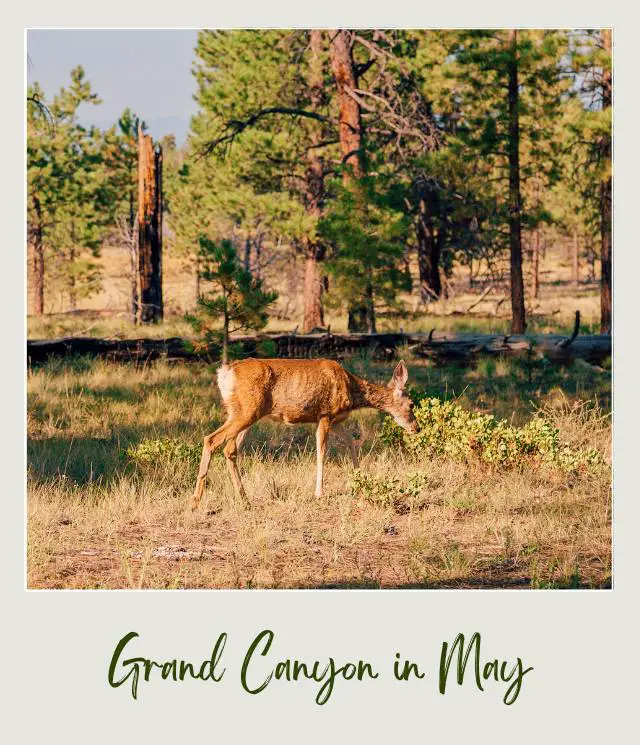
May is a prime time to explore the Grand Canyon. During a Grand Canyon May visit, you can enjoy mild weather, vibrant wildflowers, and various activities.
The Grand Canyon weather in May offers comfortable daytime temperatures ranging from 60°F to 80°F, so May is perfect for hiking and outdoor adventures, allowing you to discover the canyon’s beauty without extreme heat or cold.
The desert comes to life with blooming wildflowers like Indian paintbrush, desert mariposa, and prickly pear cactus blossoms, adding splashes of color to the arid landscape.
The pleasant May weather also makes wildlife more active, giving you the chance to observe elk, mule deer, bighorn sheep, and various bird species, including peregrine falcons and California condors. Remember your binoculars and camera to capture these unforgettable moments.
➡️ Read More: Complete Guide To Buying The Best Binoculars For The Money
Clear skies and minimal light pollution create fantastic stargazing opportunities, particularly at the Grand Canyon-Parashant National Monument, an International Dark Sky Park. The North Rim opens for the season on May 15th, weather permitting.
The National Park Service hosts various ranger-led programs, such as guided hikes, geology talks, and wildlife spotting sessions, enriching your understanding of the canyon’s natural and cultural history.
Whitewater rafting adventures down the Colorado River are ideal in May. Several outfitters offer guided trips lasting from a few days to several weeks, providing a unique perspective of the Grand Canyon.
➡️ Read More: Guide to White Water Rafting In The Grand Canyon
May marks the beginning of peak season, leading to more visitors and potential crowding at popular trails and viewpoints. To avoid congestion, consider visiting the less-travelled North Rim or exploring early in the morning or late afternoon.
While most trails are accessible in May, heavy snowfall from the previous winter can occasionally cause closures, especially in the North Rim’s higher elevations. You should monitor the National Park Service website for updates on trail conditions.
Despite generally pleasant weather in May, you should prepare for sudden rainstorms, gusty winds, or brief snow flurries, particularly at higher elevations. To fully enjoy your Grand Canyon visit in May, come equipped for varying weather conditions.
➡️ Read More: Detailed Grand Canyon Itineraries
Pros
- The Grand Canyon temperature in May ranges from mild to warm, providing comfortable conditions for outdoor activities and sightseeing
- Blooming wildflowers add color to the landscape
- Active wildlife provides numerous opportunities to observe various species
- Excellent stargazing opportunities due to clear skies and minimal light pollution
- Variety of ranger-led programs available for a richer understanding of the canyon
- The ideal time for whitewater rafting adventures on the Colorado River
Cons
- The beginning of peak season leads to more visitors and potential congestion (particularly over Memorial Day weekend)
- Possible trail closures due to heavy snowfall, in the higher elevations, from the previous winter
- Unexpected weather changes, such as rainstorms, gusty winds, or brief snow flurries
Key Events in May:
✳️ Grand Canyon Ultra Marathons – a series of trail running events in the Kaibab National Forest near the entrance to the North Rim, attracting experienced and novice runners from around the world.
✳️ Piano on the Rocks – an annual classical music festival in Sedona featuring world-class pianists playing Baroque to Contemporary music, with accompanying narratives set against the backdrop of Sedona’s natural beauty.
Visiting Grand Canyon in Summer (June-August)
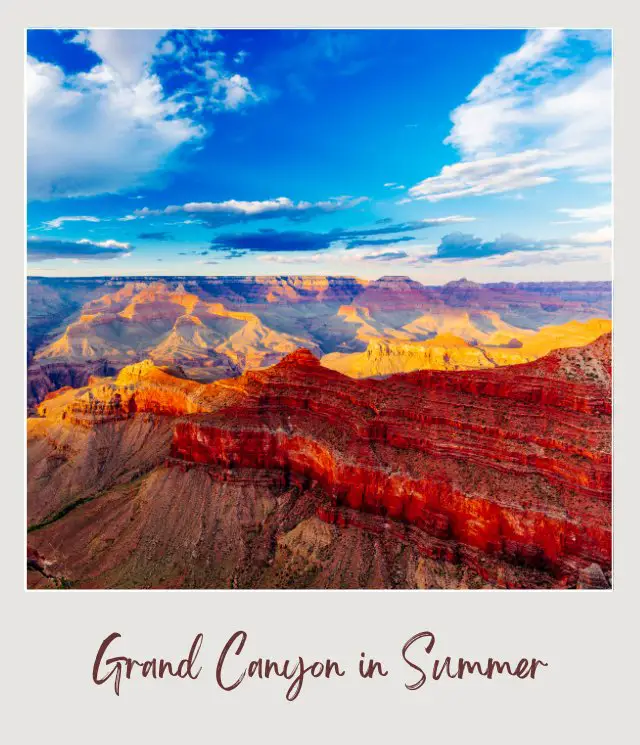
Grand Canyon in the summer months of June through August is when the park buzzes with activity under the warm sun. Although the Grand Canyon summer temperatures can be quite high, with proper planning and precautions, you can safely explore the sun-drenched landscapes and immerse yourself in the park’s awe-inspiring beauty.
Visiting Grand Canyon in June
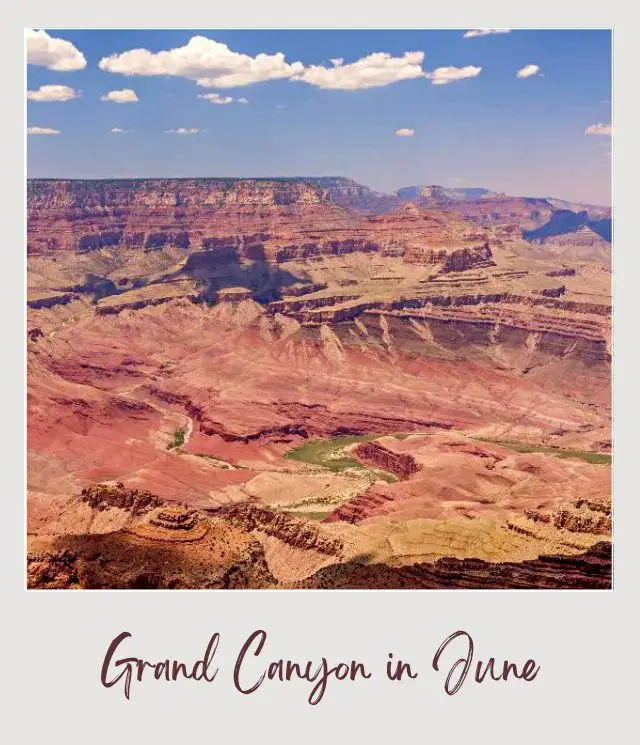
A June visit to the Grand Canyon promises a distinctive experience featuring long days, warm weather, and numerous outdoor activities.
The extended daylight hours in June provide ample time to discover the Grand Canyon’s vast landscape, allowing for longer hikes, relaxed picnics, and numerous opportunities to admire the stunning views throughout the day.
➡️ Read More: Best Grand Canyon Viewpoints
June’s warmth also brings the canyon’s diverse wildlife to life, with chances to encounter elk, mule deer, bighorn sheep, and various bird species, such as the peregrine falcon and California condor.
The warm weather is perfect for embarking on an exhilarating whitewater rafting adventure down the Colorado River, with numerous outfitters offering guided trips to experience the canyon’s beauty.
June’s clear skies and minimal light pollution create fantastic stargazing conditions, especially at the Grand Canyon-Parashant National Monument, an International Dark Sky Park.
Ranger-led programs, including guided hikes, wildlife spotting sessions, and informative talks on the canyon’s geology and cultural history, are available in June.
It’s also an ideal time to witness the blooming of various cactus species, such as the iconic saguaro and prickly pear, adding vibrant colors to the arid landscape and presenting excellent photography opportunities.
When planning your Grand Canyon June trip, prepare for hot temperatures and potential rainstorms. The Grand Canyon temperature in June sees a significant increase, with daytime highs often surpassing 100°F at the canyon’s base.
It’s essential to begin hikes early, stay hydrated, and take frequent breaks in the shade to avoid heat-related problems.
➡️ Read More: Bright Angel Trail Guide
The park becomes extremely busy when school lets out in June, which can result in crowded trails and viewpoints, but exploring the less-traveled North Rim or hiking during off-peak hours can help you avoid congestion.
Pros
- Longer daylight hours for extended exploration
- Active wildlife for spotting various species
- Ideal warm weather for whitewater rafting trips
- Clear skies and minimal light pollution for stargazing
- A variety of ranger-led programs are available
- Blooming cactus species, providing great photography opportunities
Cons
- High temperatures can potentially lead to heat-related issues
- Crowded trails and viewpoints due to the popularity of June visits
- Possibility of sudden rainstorms and flash floods during monsoon season
Key Events in June:
✳️ Grand Canyon Star Party – an annual June event for amateur astronomers and enthusiasts of all ages at the Grand Canyon National Park in Arizona, featuring stunning night skies and camaraderie, with or without telescopes.
✳️ Flagstaff Folk Festival – features over 70 folk and acoustic music acts from Arizona and beyond across three stages at the Museum Club in Flagstaff.
✳️ Williams Historic Route 66 Car Show – a celebration of classic cars and the iconic Route 66 in Williams, Arizona. The event features vintage cars, live music, food, and a parade down the historic Route 66.
Visiting the Grand Canyon in July
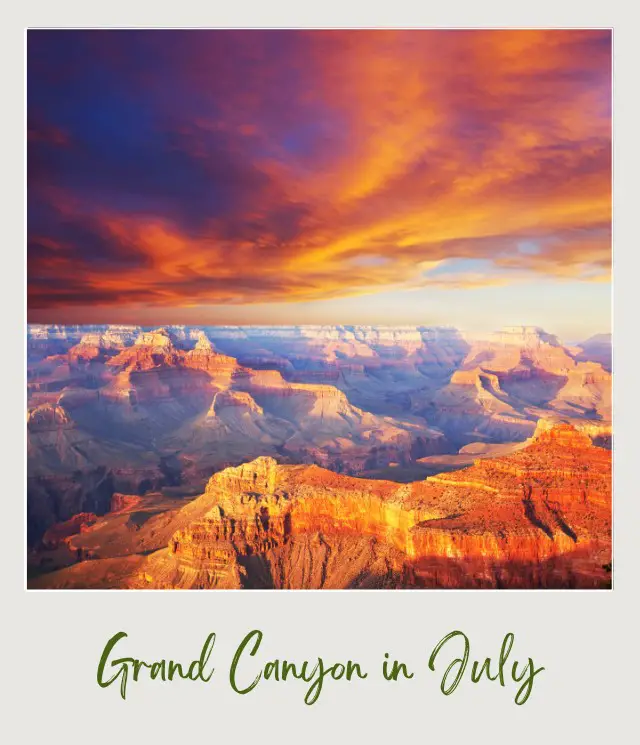
Taking a trip to the Grand Canyon in July offers unique opportunities and concerns as the warm weather, monsoon season, and numerous outdoor activities shape your experience. When it comes to an average temperature, Grand Canyon July visits can pose some challenges.
The Grand Canyon’s abundant wildlife becomes active in July due to the warm weather. Keep an eye out for various bird species like the peregrine falcon and California condor, as well as elk, mule deer, and bighorn sheep. Additionally, the heat generates ideal circumstances for an exhilarating whitewater rafting excursion along the Colorado River.
In July, the National Park Service provides ranger-led programs comprising various activities, such as guided hikes, wildlife spotting sessions, and informative talks on the canyon’s geology and cultural history.
The monsoon season presents captivating skies with towering thunderheads and stunning sunsets in July, offering unparalleled photo opportunities and breathtaking views of the canyon’s terrain.
Despite the occasional cloud cover, July offers clear skies for stargazing, especially at the Grand Canyon-Parashant National Monument, an International Dark Sky Park. You might also catch a glimpse of late-blooming wildflowers, such as desert sunflowers and blackfoot daisies, adding vibrant hues to the canyon’s arid surroundings.
When it comes to the average temperature in Grand Canyon in July, heat can be extreme. The Grand Canyon temperature in July often reaches over 100°F at the canyon’s base. To prevent heat-related problems, begin hiking early, stay well-hydrated, and take frequent breaks in shaded areas.
July is a busy time for visitors to the Grand Canyon, resulting in crowded trails and viewpoints. You can explore the less frequented North Rim or go hiking during off-peak hours to avoid the crowds.
Pros
- Active wildlife for spotting various species
- Excellent time for whitewater rafting adventures
- A variety of ranger-led programs are available
- Dramatic skies and striking sunsets for unique photo opportunities
- Clear skies for stargazing
- Late-blooming wildflowers add vibrant colors to the landscape
Cons
- Grand Canyon temperature: July scorching temperatures can potentially lead to heat-related issues
- Sudden rainstorms, thunderstorms, and flash floods due to monsoon season
- Crowded trails and viewpoints due to the popularity of July visits (particularly around Independence Day)
Key Events in July:
✳️ Flagstaff Art in the Park – a locally owned festival featuring unique fine art and crafts by over 70 artists from the Southwest. It takes place on the Fourth of July and Labor Day weekends in Downtown Flagstaff’s Wheeler Park, with live music, food, and a Shady Beer Garden.
Visiting the Grand Canyon in August
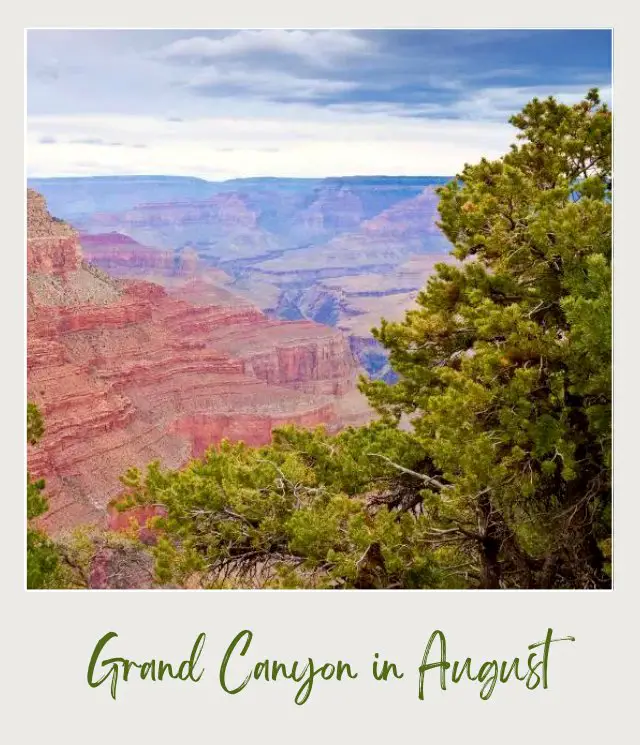
A Grand Canyon August visit combines hot temperatures, monsoon rains, and diverse outdoor recreational opportunities.
In August, the canyon’s rich fauna becomes more active due to the warm weather, offering an excellent opportunity to observe elk, mule deer, bighorn sheep, and various bird species, including the peregrine falcon and California condor. The high temperatures also create perfect conditions for thrilling whitewater rafting expeditions on the Colorado River.
Throughout August, the National Park Service provides ranger-led activities that include guided hikes, wildlife observation sessions, and educational talks on the cultural history and geology of the canyon.
➡️ Read More: 30 Fun Things To Do In Grand Canyon National Park
August marks the monsoon season, which generates striking skies with remarkable thunderheads and gorgeous sunsets, creating unique chances for photography and unforgettable glimpses of the scenery.
Although clouds may appear, August generally offers clear skies perfect for stargazing. The Grand Canyon-Parashant National Monument, an International Dark Sky Park, is an ideal spot to observe the night sky, including the Perseid meteor shower on clear nights. During your visit, you might also encounter late-summer wildflowers such as the desert sunflower and blackfoot daisy, which add vibrant splashes of color to the canyon’s landscape.
August is one of the hottest months at the Grand Canyon, where temperatures at the canyon’s base can go beyond 100°F. To prevent heat-related problems, start your hikes early in the morning, stay hydrated, and take breaks frequently in the shade. Since August falls during the monsoon season, you must also prepare for unexpected rainstorms, thunderstorms, and flash floods. Always check the weather forecast before you start hiking.
August tends to be a busy month for the Grand Canyon, leading to crowded trails and viewpoints. To avoid the crowds, consider exploring the lesser-known North Rim or opting for off-peak hours for your hikes.
Pros
- Active wildlife for spotting various species
- Fantastic time for thrilling whitewater rafting adventures
- A variety of ranger-led programs are available
- Dramatic skies and vivid sunsets for unique photo opportunities
- Clear skies for stargazing
- Late-summer wildflowers add vibrant colors to the landscape
Cons
- Grand Canyon temperature in August: sweltering temperatures that can potentially lead to heat-related issues
- Sudden rainstorms, thunderstorms, and flash floods due to monsoon season
- Crowded trails and viewpoints due to the popularity of August visits
Key Events in August:
✳️ HOPI Festival of Arts & Culture – a vibrant celebration of Hopi culture and artistic ability. The festival offers the chance to admire breathtaking art, enjoy traditional social dances, and learn about Hopi traditions and the way of life through educational exhibits. It promotes unity, happiness, and stewardship of the earth, bringing together people from different walks of life to celebrate diversity and community.
Grand Canyon in Fall (September-November)
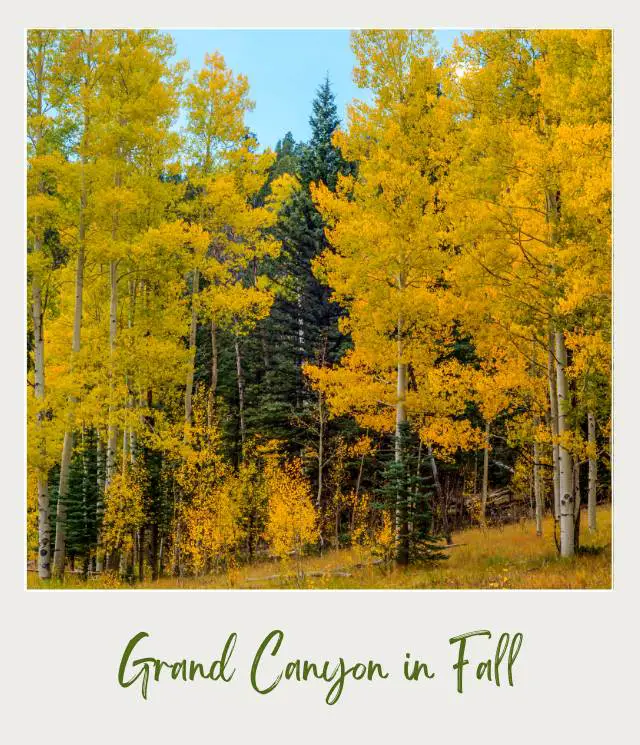
The enchanting beauty of the Grand Canyon in the fall is highlighted by the vibrant foliage, cooler temperatures, and serene atmosphere, creating a captivating experience for every visitor.
Let’s take a look at the best time to visit Grand Canyon in the fall.
Visiting Grand Canyon in September

Visiting the Grand Canyon in September offers a distinctive experience characterized by mild weather, stunning autumn colors, and a decline in the bustling tourist season.
When visiting Grand Canyon in September, weather conditions are typically mild and enjoyable. The Grand Canyon temperature in September gradually decreases, making it a more comfortable month for hiking and outdoor activities. A
lthough daytime highs at the canyon’s bottom can still reach 90s°F, the refreshing mornings and evenings provide a welcome break. As the month unfolds, the North Rim’s foliage transforms, with aspens and oaks displaying an eye-catching array of oranges, yellows, and reds.
Despite the cooler weather, encounters with the Grand Canyon’s diverse wildlife remain possible, including sightings of elk, mule deer, bighorn sheep, and various bird species like the peregrine falcon and California condor.
You might also come across some late-blooming wildflowers like the desert sunflower and blackfoot daisy, which bring vivid colors to the otherwise dry terrain.
September’s clear skies and minimal light pollution create excellent stargazing opportunities, particularly at the Grand Canyon-Parashant National Monument, an International Dark Sky Park.
In September, the National Park Service provides various ranger-led activities, including informative talks on the cultural history and geology of the canyon, wildlife spotting sessions, and guided hikes.
September’s weather can be somewhat unpredictable, encompassing the tail end of the monsoon season and the potential for early snow at higher elevations. Be prepared for sudden weather shifts and pack suitable clothing. The North Rim begins to wind down for the season in September, with some facilities closing by mid-October, which may limit your options for lodging, dining, and services.
Although there is still plenty of daylight for exploration, the days grow shorter in September, requiring careful planning to maximize your available time.
Pros
- A gradual drop in temperatures makes it more comfortable for outdoor activities
- Changing colors of foliage, creating a picturesque backdrop
- Grand Canyon weather in September is cooler and allows for wildlife encounters
- Clear skies and minimal light pollution for fantastic stargazing opportunities
- A variety of ranger-led programs are available
- Late-blooming wildflowers add vibrant colors to the landscape
Cons
- A mix of weather conditions, including the tail end of monsoon season and possibly early snow at higher elevations
- North Rim facilities begin to close for the season, limiting options for accommodations, dining, and services
- Shorter days require more careful planning to maximize available time
Key Events in September:
✳️ Grand Canyon Music Festival – brings some of the top names in instrumental music to the Shrine of the Ages, located in the heart of Grand Canyon Village on the South Rim. The lineup changes every year, so you never know what kind of musical treats are in store. The festival has something for everyone, from harmonicas to electric violins, vocalists, to storytellers.
✳️ Grand Canyon Celebration of Art – an annual week-long event that showcases the plein air activity of participating artists who create artwork inspired by the Grand Canyon.
Visiting Grand Canyon in October
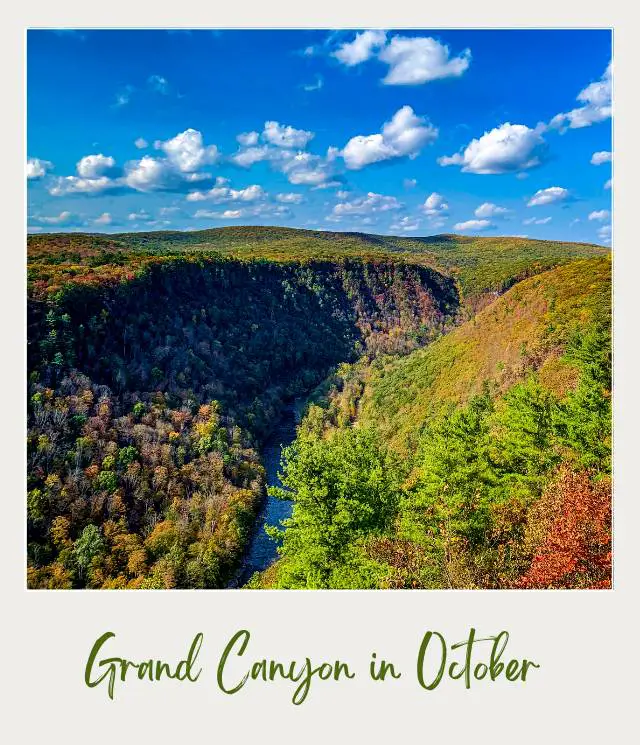
Visiting Grand Canyon National Park in October is a delightful experience, characterized by cooler temperatures, stunning fall colors, and fewer tourists.
With cooler temperatures arriving in October, hiking and outdoor activities become more comfortable. While Grand Canyon temperature in October can reach a daytime high of 80°F at Phantom Ranch at the canyon’s bottom, the crisp mornings and evenings provide a refreshing contrast. The North Rim comes alive in October as the aspens and oaks display a striking array of oranges, yellows, and reds, setting the perfect scene for your Grand Canyon journey.
➡️ Read More: How to Make Reservations at Phantom Ranch
In October, there is a decline in the number of visitors, which means less crowded observation points and hiking trails.
This month also offers unobstructed sky views and reduced light contamination, providing excellent stargazing opportunities, particularly at the Grand Canyon-Parashant National Monument, recognized as an International Dark Sky Park.
In October, the National Park Service provides ranger-led programs that include guided hikes, sessions for wildlife spotting, and informative talks on the cultural history and geology of the canyon.
The cooler weather during this time of the year offers excellent opportunities to observe the diverse wildlife inhabiting the canyon, such as elk, mule deer, bighorn sheep, and different bird species, such as the peregrine falcon and California condor.
The North Rim begins to close for the season in October, with facilities shutting down by mid-October and the entire North Rim closing to vehicle traffic by October 15th (weather permitting). It may limit your options for lodging, dining, and services. Additionally, October can bring a mix of weather conditions, such as early snow at higher elevations. Be prepared for sudden weather changes and pack appropriate clothing.
Although there is still plenty of daylight for exploration, days grow shorter in October, necessitating careful planning to maximize your available time.
Pros
- Grand Canyon weather in October: cooler temperatures make it more comfortable for outdoor activities
- Vibrant fall colors on the North Rim create a picturesque backdrop
- The decline in visitor numbers provides a more peaceful experience (except for Thanksgiving)
- Clear skies and minimal light pollution for fantastic stargazing opportunities
- A variety of ranger-led programs are available
- Cooler weather allows for wildlife encounters
Cons
- North Rim begins to shut down for the season, limiting options for accommodations, dining, and services
- A mix of weather conditions, including the possibility of early snow at higher elevations
- Shorter days require more careful planning to maximize available time
Key Events in October:
✳️ Flagstaff Oktoberfest Festival – an annual festival in Flagstaff, Arizona, that celebrates the arrival of autumn with traditional German food and drink, including bratwurst, pretzels, and plenty of beer. Alongside the food and drink, guests can enjoy traditional polka music, a stein holding competition, and a brat eating contest.
Grand Canyon – November

You may wonder whether visiting the Grand Canyon in November is a good idea and what the Grand Canyon weather in November is like.
Visiting Grand Canyon in November provides a peaceful and serene experience due to the colder climate and off-season conditions. If you look at the Grand Canyon weather, November is a good month to visit.
With a significant decline in visitor numbers, November provides a more peaceful and intimate experience at popular viewpoints and trails. It allows for better photo opportunities and a leisurely pace to savor the canyon’s beauty.
When it comes to the weather in Grand Canyon in November, the colder temperatures make hiking more comfortable, especially at lower elevations. The Grand Canyon temperature in November at the canyon’s bottom has daytime highs ranging from 60-70°F.
Wildlife enthusiasts will find November an ideal time for observing a diverse range of creatures, such as elk, mule deer, bighorn sheep, and several bird species, including peregrine falcons and California condors.
In addition, the month presents clear skies and little light pollution, providing exceptional stargazing experiences, especially at the Grand Canyon-Parashant National Monument, an International Dark Sky Park.
Throughout November, the National Park Service continues to offer ranger-led programs, such as guided hikes, wildlife spotting sessions, and educational talks on the canyon’s geology and cultural history.
While the peak of fall colors typically occurs in October, you may still encounter some late fall foliage in the canyon when visiting Grand Canyon in early November, particularly at lower elevations and along the Colorado River corridor.
The North Rim is closed to vehicle traffic from mid-October to mid-May, restricting access to this part of the park. Facilities and services on the North Rim are also unavailable during this period.
➡️ Read More: How To Get To Grand Canyon National Park
During your trip to the Grand Canyon in November, weather conditions tend to be more unpredictable, including rain and the possibility of snow at higher elevations. It’s essential to come prepared with layers and appropriate gear for your outdoor adventures.
Days are shorter in November, necessitating careful planning to maximize your available time for exploring the canyon.
Pros
- A significant drop in visitor numbers, providing a more peaceful experience
- Grand Canyon November weather: colder temperatures make it comfortable for hiking at lower elevations
- Good time for spotting wildlife
- Clear skies and minimal light pollution for fantastic stargazing opportunities
- Ranger-led programs continue to be offered
- Possible late fall foliage
Cons
- North Rim closed to vehicle traffic and limited facilities/services
- A mix of weather conditions, including rain and possible snow at higher elevations
- Shorter days require more careful planning to maximize available time
Key Events in November:
✳️ Grand Canyon Polar Express – a magical winter wonderland experience. The train journey is decorated with twinkling lights and festive decorations, passing snow-covered forests and majestic mountains. It includes activities like snowman building, sledding, hot chocolate, cookie decorating, and a visit from Santa.
✳️ Grand Canyon Trail Half Marathon & 5K – offers a challenging and incredible forested run next to the Grand Canyon National Park, featuring stunning views of tree-lined cliffs, a cross-under historic railroad tracks, and possible wildlife sightings.
✳️ Native American Heritage Days – celebrates the unique and ancient cultural heritage of the area’s indigenous tribes. The event features guest speakers, artisans, singers, and dancers who showcase the many accomplishments, contributions, and sacrifices made by the tribes. From the Havasupai to the Navajo, each tribe’s culture is expressed through their art, songs, and people.
Visiting Grand Canyon in Winter (December-April)
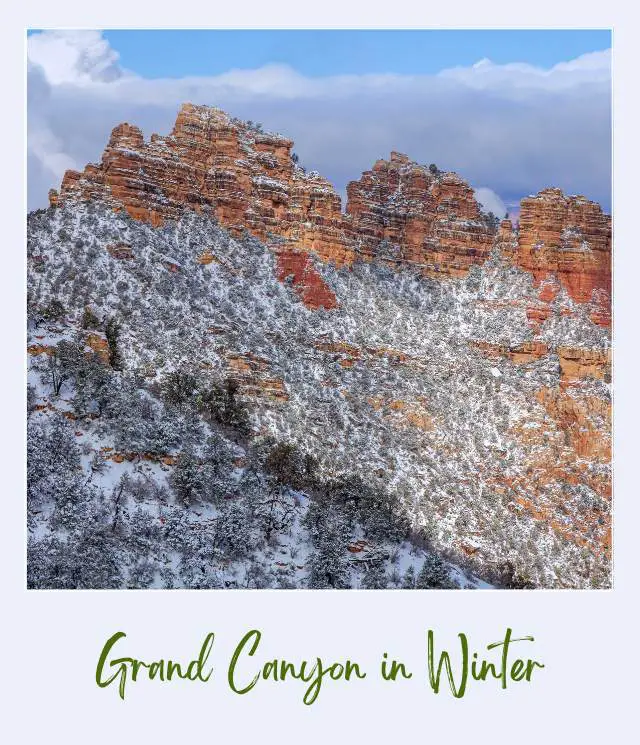
You may wonder: “Is it OK to visit Grand Canyon in winter?” The answer is a resounding yes, with proper planning and precautions.
Visiting Grand Canyon during winter, a season that transforms the park into a wonderland of snow-capped peaks and frosty landscapes, is unique experience.
The tranquility and beauty of winter in Grand Canyon National Park create a mesmerizing atmosphere, offering visitors a unique experience amidst snow-capped peaks and frosty landscapes.
Let’s look at the Grand Canyon National Park winter visit in more detail.
Grand Canyon National Park in December
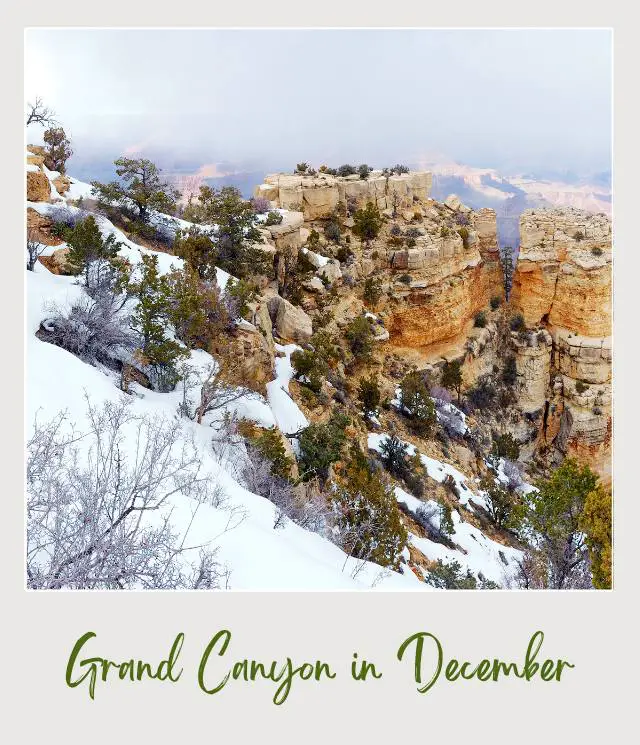
Is December a good time to visit Grand Canyon? Keep reading to find out!
A December visit to the Grand Canyon offers a unique and serene experience as winter sets in, bringing colder temperatures and a snow-dusted landscape. Here’s an overview of what to expect during your December adventure, including the pros and cons of exploring the canyon at this time of year.
December is the least crowded month at the Grand Canyon, making your experience even more peaceful and intimate as you enjoy the canyon’s natural beauty without the usual crowds of tourists.
With winter comes the possibility of snow, creating a striking contrast between the white snow and the canyon’s red rocks. The South Rim, at higher elevations, is more likely to have snow, presenting stunning photo opportunities.
December is an excellent time for wildlife sightings since some animals, like mule deer and elk, are more active during the colder months. Look out for bighorn sheep, various bird species, and even bald eagles.
The month also offers clear skies and minimal light pollution, providing fantastic stargazing opportunities, particularly at the Grand Canyon-Parashant National Monument, an International Dark Sky Park.
Throughout December, the National Park Service continues to offer ranger-led programs. December can still be a great time for hiking in the canyon. Trails may be less crowded, and the cooler temperatures can make hiking more comfortable. However, always check trail conditions and be prepared for icy or snow-covered paths.
The North Rim is closed to vehicle traffic from mid-October to mid-May, restricting access to this part of the park. Facilities and services on the North Rim are also unavailable during this period.
When it comes to the Grand Canyon weather in December, you must prepare for chilly temperatures and pack suitable clothing, including layers, hats, gloves, and warm footwear.
➡️ Read More: Best Microspikes for Hiking
December has the shortest day of the year, which means less time for exploring the canyon. Plan your activities accordingly and consider starting hikes early to maximize the daylight.
Pros
- Fewest visitors of any month, providing a peaceful and intimate experience
- Snow creates a stunning contrast with the canyon’s red rocks
- Excellent time for wildlife sightings
- Clear skies and minimal light pollution for fantastic stargazing opportunities
- Ranger-led programs continue to be offered
- Cooler temperatures for more comfortable hiking
Cons
- North Rim closed to vehicle traffic and limited facilities/services
- Grand Canyon temperature in December: colder temperatures require warm clothing and preparation
- Shortest days of the year, meaning less time for exploration
- Unpredictable weather and possible icy or snow-covered trails
Key Events in December:
✳️ Grand Canyon Polar Express – a magical winter wonderland experience. The train journey is decorated with twinkling lights and festive decorations, passing snow-covered forests and majestic mountains. It includes activities like snowman building, sledding, hot chocolate, cookie decorating, and a visit from Santa.
Grand Canyon National Park in January
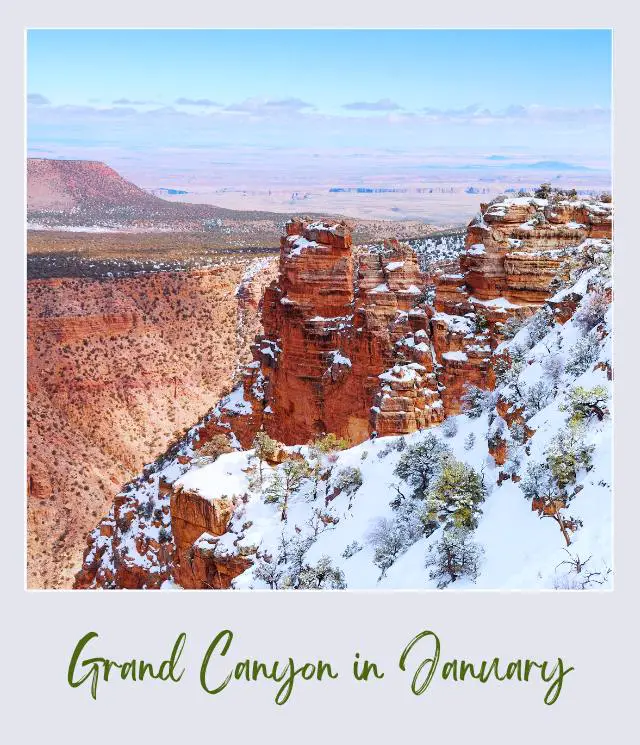
When you visit the Grand Canyon in January, you’ll have the opportunity to experience a peaceful and serene atmosphere due to the cold temperatures and snow that come with the heart of winter.
Despite the cold Grand Canyon weather in January, it’s a good time to visit as it’s one of the least crowded months. You’ll be able to explore and appreciate the canyon’s beauty without the usual crowds, and the park’s tranquility during this time is unmatched.
The South Rim is often blanketed in snow during January, creating a breathtaking contrast between the snow-covered canyon walls and the vivid colors of the rocks below. It creates an excellent opportunity for taking stunning photographs and making unforgettable memories.
Winter months attract a variety of wildlife to the canyon, including elk, mule deer, and bighorn sheep. Bird enthusiasts may spot bald eagles, hawks, and other birds of prey soaring above the canyon.
The clear winter skies offer fantastic stargazing opportunities, with minimal light pollution and excellent visibility. The Grand Canyon-Parashant National Monument, an International Dark Sky Park, is an ideal location to admire the night sky.
Despite the cold weather, the National Park Service continues to offer ranger-led programs in January, which may include guided hikes, wildlife viewing sessions, and educational talks on the canyon’s geology, ecology, and cultural history.
While the Grand Canyon doesn’t have designated cross-country skiing trails, the nearby Kaibab National Forest offers groomed trails for this winter activity, providing a unique way to experience the region’s beauty.
➡️ Read More: The Best Snowshoes for Beginners
The North Rim is closed to vehicle traffic from mid-October to mid-May, limiting access to this part of the park. Facilities and services on the North Rim are also unavailable during this time.
January is the coldest month at the Grand Canyon, with average high temperatures around 44°F on the South Rim and lows frequently dropping below freezing. Pack suitable clothing, including layers, hats, gloves, and insulated footwear.
Snow and ice can make hiking trails slippery and challenging to navigate. It’s crucial to check trail conditions before hiking and come prepared with proper footwear and hiking gear.
Pros
- Among the least crowded months, providing tranquility
- Snow creates a striking contrast with the canyon’s colors for excellent photographs
- Winter months bring a variety of wildlife to the canyon
- Clear winter skies offer fantastic stargazing opportunities
- Ranger-led programs continue despite cold weather
- Nearby Kaibab National Forest offers groomed trails for cross-country skiing
Cons
- North Rim closed to vehicle traffic and limited facilities/services
- Grand Canyon temperature in January: it’s the coldest month, with temperatures often below freezing, requiring warm clothing
- Snow and ice can make hiking trails slippery and challenging to navigate
Key Events in January:
✳️ Grand Canyon Polar Express – a magical winter wonderland experience. The train journey is decorated with twinkling lights and festive decorations, passing snow-covered forests and majestic mountains. It includes activities like snowman building, sledding, hot chocolate, cookie decorating, and a visit from Santa.
Visiting the Grand Canyon in February

Visiting the Grand Canyon National Park in February offers an enchanting adventure as the winter unveils a captivating sight of the frost-dressed canyon.
February is one of the least crowded months at the Grand Canyon, so you can enjoy the park’s natural wonders in a peaceful and intimate atmosphere. With fewer visitors, you’ll have more chances to explore popular spots without the typical hustle and bustle.
➡️ Read More: The Best Airports Near The Grand Canyon
When it comes to the Grand Canyon weather in February, snowfall is common, adding a serene layer of white to the canyon’s already breathtaking views. The snow contrasts beautifully with the colorful layers of the canyon walls, creating a unique and picturesque landscape.
The park comes alive during winter, particularly in February, offering an ideal chance to observe its diverse wildlife. Among the creatures you might come across are majestic elk, graceful mule deer, magnificent bighorn sheep, and a wide array of bird species, including bald eagles and other raptors.
A Grand Canyon February visit rewards visitors with extraordinary stargazing experiences on clear winter nights. The opportunities to marvel at the celestial wonders are truly exceptional thanks to minimal light pollution and dark skies in the nearby Grand Canyon-Parashant National Monument, designated as an International Dark Sky Park.
Despite the colder temperatures, the National Park Service offers ranger-led programs in February, including guided walks, wildlife viewing sessions, and informative talks about the canyon’s history, geology, and ecology.
While some trails may be icy or snow-covered, February is still an excellent time for winter hiking in the Grand Canyon. The South Kaibab and Bright Angel trails are typically maintained during the winter, offering visitors the chance to explore the canyon’s depths amidst the quiet and stillness of the season.
➡️ Read More: Winter Hiking Gear List
The North Rim remains closed to vehicle traffic and facilities from mid-October to mid-May. During this time, access to the North Rim is limited, restricting your exploration options.
February at the Grand Canyon can be chilly, with average high temperatures around 46°F on the South Rim and overnight lows frequently below freezing. Pack warm clothing, including layers, hats, gloves, and insulated footwear.
Snow and ice may cover trails, making them slippery and potentially hazardous. It’s crucial to check trail conditions before hiking and to be equipped with appropriate footwear and gear.
➡️ Read More: The Best Microspikes for Hiking
Pros
- One of the least busy months, providing a peaceful and intimate experience
- Snowfall creates a serene and picturesque landscape
- Ample opportunities to spot wildlife
- Clear winter nights offer exceptional stargazing opportunities
- Ranger-led programs continue despite colder temperatures
- Excellent time for winter hiking on maintained trails
Cons
- North Rim closed to vehicle traffic and limited facilities/services
- Grand Canyon temperature in February: chilly temperatures with overnight lows frequently below freezing, requiring warm clothing
- Snow and ice may cover trails, making them slippery and potentially hazardous
Visiting Grand Canyon in March
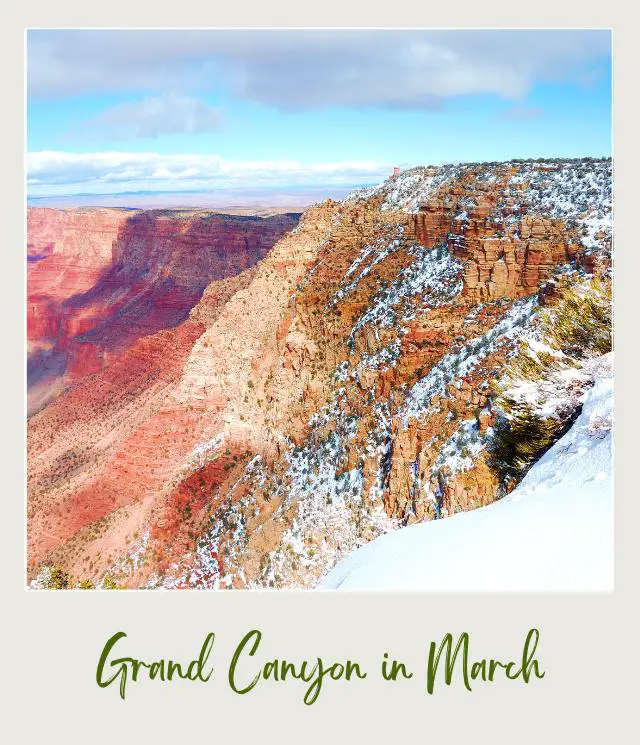
Is the Grand Canyon open in March? Yes and no. While the South Rim is open year-round, the North Rim remains closed to vehicle traffic and facilities until mid-May, limiting your exploration options, as you won’t have access to the North Rim’s viewpoints and trails during your March visit.
However, March at the Grand Canyon offers a unique experience, blending the lingering winter scenery with spring awakening. Here are the pros and cons of the Grand Canyon March visit and some distinctive things you can expect during this month.
Visiting the Grand Canyon in March presents a unique combination of winter and spring, with mild temperatures and emerging wildflowers.
As March unfolds, the first signs of spring appear, with wildflowers blooming in the lower elevations. You’ll witness bursts of color as you explore the trails, making for picturesque views and delightful hikes.
Although the Grand Canyon begins to see more visitors in March, the crowds are still relatively manageable, allowing you to enjoy popular viewpoints and trails without being overwhelmed by crowds of tourists.
The Grand Canyon weather in March boasts milder temperatures than winter, with average highs around 53°F on the South Rim. It makes hiking and exploring the park more comfortable during the day.
As the season transitions from winter to spring, you can observe various animals, such as elk, mule deer, bighorn sheep, and numerous bird species, including the peregrine falcon and the endangered California condor.
Clear spring nights offer exceptional stargazing opportunities at the Grand Canyon. You can admire the night sky away from city lights and even attend stargazing programs offered by the park’s rangers.
In March, the National Park Service continues to provide ranger-led programs, including guided walks, wildlife viewing sessions, and informative talks about the canyon’s geology, history, and ecology.
March’s weather can be unpredictable, with the possibility of snow, rain, or even a late-season snowstorm. Be prepared for variable conditions by dressing in layers and checking the weather forecast before your visit.
Melting snow and rain can result in muddy and slippery trails, making hiking more challenging. It’s essential to check trail conditions before embarking on any hikes and to wear appropriate footwear.
Pros
- Emerging wildflowers create picturesque views and delightful hikes
- Manageable crowds at popular viewpoints and trails
- Grand Canyon temperature in March: milder temperatures compared to winter months
- Opportunity to observe various animals
- Exceptional stargazing opportunities on clear spring nights
- Ranger-led programs continue in March
Cons
- Unpredictable weather with the possibility of snow, rain, or late-season snowstorms
- North Rim closed to vehicle traffic and facilities until mid-May
- Melting snow and rain can result in muddy and slippery trails
Visiting Grand Canyon in April
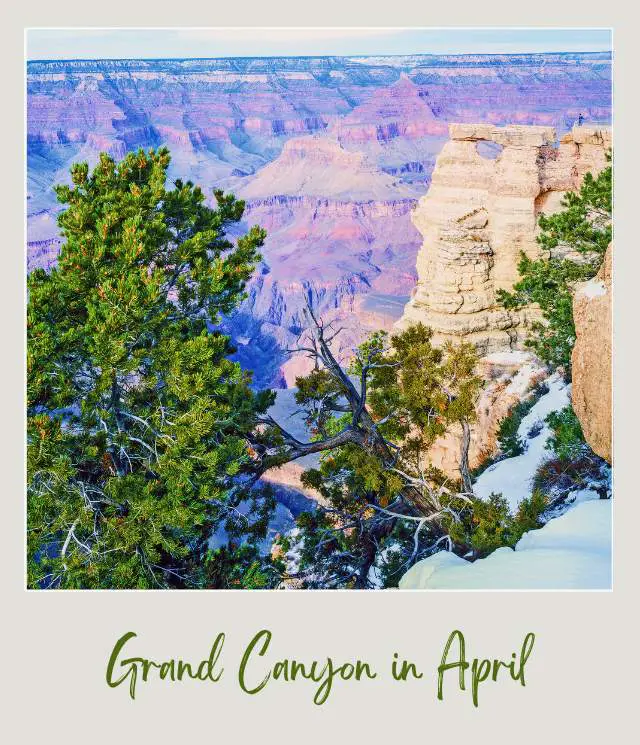
April at the Grand Canyon is a month of transformation, offering visitors the chance to witness nature’s revival after the winter season. Here are the pros, cons, and unique aspects that make visiting the Grand Canyon in April a memorable experience.
April is a fantastic time to see vibrant wildflower displays throughout the park. As you explore the canyon, you’ll encounter colorful blossoms that add a touch of magic to the already breathtaking landscape.
April brings warmer temperatures, with average highs around 61°F on the South Rim, making it a pleasant time for hiking and sightseeing. However, the weather can still be unpredictable, so it’s essential to dress in layers and be prepared for sudden changes, especially when visiting Grand Canyon in early April.
Although the number of visitors increases in April, the park is still relatively uncrowded compared to the peak summer months. It allows you to enjoy popular trails and viewpoints without excessive congestion.
A Grand Canyon April visit is a great time to observe various wildlife in the park, including elk, mule deer, bighorn sheep, and numerous bird species like the peregrine falcon and the endangered California condor.
The park offers a range of ranger-led programs in April, including guided walks, informative talks, and wildlife-watching sessions that will enrich your understanding of the Grand Canyon’s history, geology, and ecology.
Clear April nights provide exceptional opportunities for stargazing at the Grand Canyon. Far from city lights, you can admire the vast night sky and attend stargazing programs hosted by the park’s rangers.
The North Rim remains closed to vehicle traffic and facilities until mid-May, limiting your options for exploration. You won’t have access to the North Rim’s viewpoints and trails during your April visit.
April can bring sunny days, rain, and occasional snowfall. It’s crucial to check the weather forecast before your visit and to pack suitable clothing for variable conditions.
Some backcountry campsites may still be inaccessible as the snow melts due to muddy or wet conditions. Be sure to check the availability of specific campsites before planning any overnight hikes.
Pros
- Vibrant wildflower displays throughout the park.
- Grand Canyon temperature in April: warmer temperatures with average highs around 62°F (17°C) on the South Rim.
- Relatively uncrowded compared to peak summer months.
- Opportunity to observe wildlife, including elk, mule deer, bighorn sheep, and numerous bird species.
- Ranger-led programs include guided walks, informative talks, and wildlife-watching sessions.
- Exceptional stargazing opportunities due to clear April nights.
Cons
- Unpredictable weather, with sunny days, rain, and occasional snowfall.
- North Rim is closed to vehicle traffic and facilities until mid-May.
- Some backcountry campsites may still be inaccessible due to muddy or wet conditions.
Key Events in April:
✳️ National Park Week – celebrated annually in mid-April in conjunction with Earth Day, which offers free admission to all national parks in the US.
✳️ Sedona Yoga Festival – a transformative experience for all yogis, with a range of offerings against the stunning Sedona backdrop.
Deciding when to go to Grand Canyon National Park for is a very important step in planning your trip, and I hope this guide is helping.
However, as I’m sure you’re very aware, this is just one thing of many to decide. Once you’ve decided the timing of your trip, you still need to make an actual plan.
In fact, the thing that most people ask me about is how to put it all together into an itinerary that makes sense. They decide when they’ll go and maybe even book their flights, but still worry about how to minimize the crowds, what to do – and when – and how to coordinate it all.
To help take away the overwhelm of planning a trip to Grand Canyon National Park, I’ve created several super detailed itineraries.
Without them, people often feel stressed about planning their trip. With them, they have the confidence of getting all the info they need in one spot. Plus, there’s flexibility built in, so they can easily adapt them to their own interests and activity levels.
There are 1-, 2-, and 3- day options for the South Rim: all with detailed hour-by-hour schedules, including alternatives for different activity and fitness levels, plus trail maps and descriptions, driving instructions, important information, essential tips, and everything else you need to make the most of your time in Grand Canyon National Park. I also offer a more basic itinerary for the North Rim.
Travel Insurance for Grand Canyon National Park
No matter when you go to Grand Canyon National Park, you should definitely get travel insurance. This can protect you not only against medical and emergency repatriation, but can also cover things like trip cancellation, loss and/ or theft of property, etc.
➡️ A great insurance option is Travelex. It has coverage for all you’ll need. You can compare Travel Insurance plans here or get a quote right now:
Enjoy Grand Canyon National Park!
Additional Planning Resources for Grand Canyon National Park
⭐ Grand Canyon Guide
⭐ Grand Canyon South Rim Deluxe Itinerary
⭐ Grand Canyon North Rim Basic Itinerary
⭐ Planning A Trip to Grand Canyon National Park
⭐ How Long to Stay in Grand Canyon National Park
⭐ White Water Rafting In The Grand Canyon
⭐ Best Things To Do In Grand Canyon (South Rim)
⭐ Best Grand Canyon Viewpoints
⭐ Top Tips for Visiting Grand Canyon National Park
⭐ Complete Guide To Hiking The Bright Angel Trail
⭐ How To Get To Grand Canyon National Park
⭐ The Best Airports Near The Grand Canyon
⭐ Reservations For Phantom Ranch, Grand Canyon
⭐ The Airport Nearest Grand Canyon National Park
⭐ Best Time to Visit Grand Canyon National Park
⭐ Best Books about the Grand Canyon
⭐ Vacation Rentals In and Near Grand Canyon National Park
⭐ Vacation rentals in Flagstaff
⭐ Vacation rentals in Sedona
⭐ 12 Fun Facts About the Grand Canyon
⭐ 5 Best Easy Hikes in Grand Canyon National Park
⭐ 15 Best Things to Do in Grand Canyon for Non Hikers
Subscribe to daily national parks planning tips, travel inspiration and trip ideas and get instant access to the free PDF of this guide to
Visiting Grand Canyon National Park Throughout The Year
What do you think is the best time of year to visit Grand Canyon National Park? Join my private Facebook group National Parks Collectors and comment and let me know (you can also pick up extra planning tips, share your photos and stories with other national park lovers and more).
If you liked this article about the best time to see Grand Canyon National Park, Pin It to your Grand Canyon National Park board!
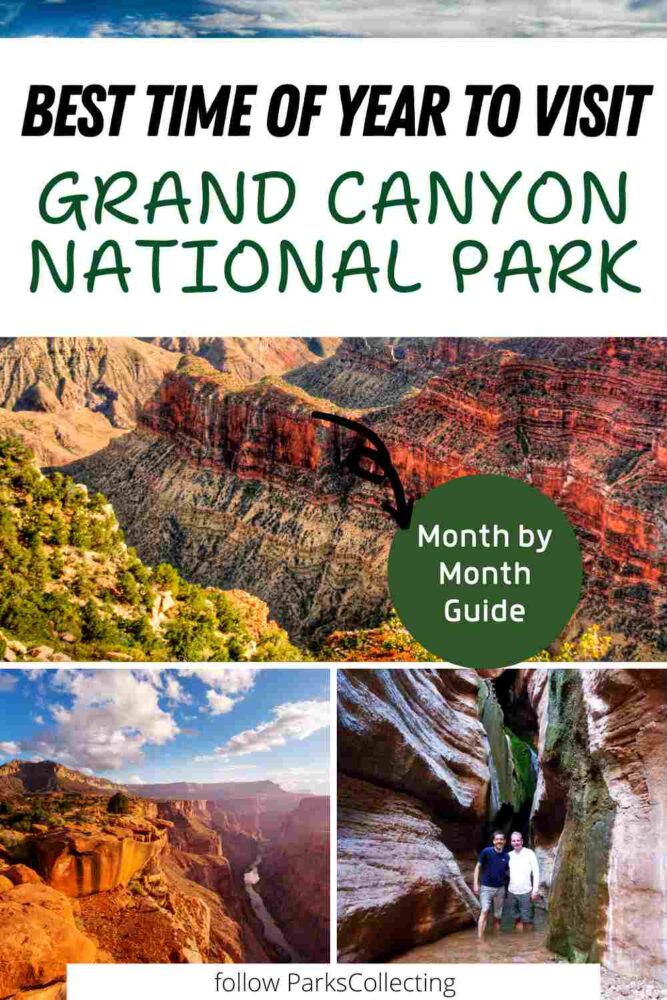
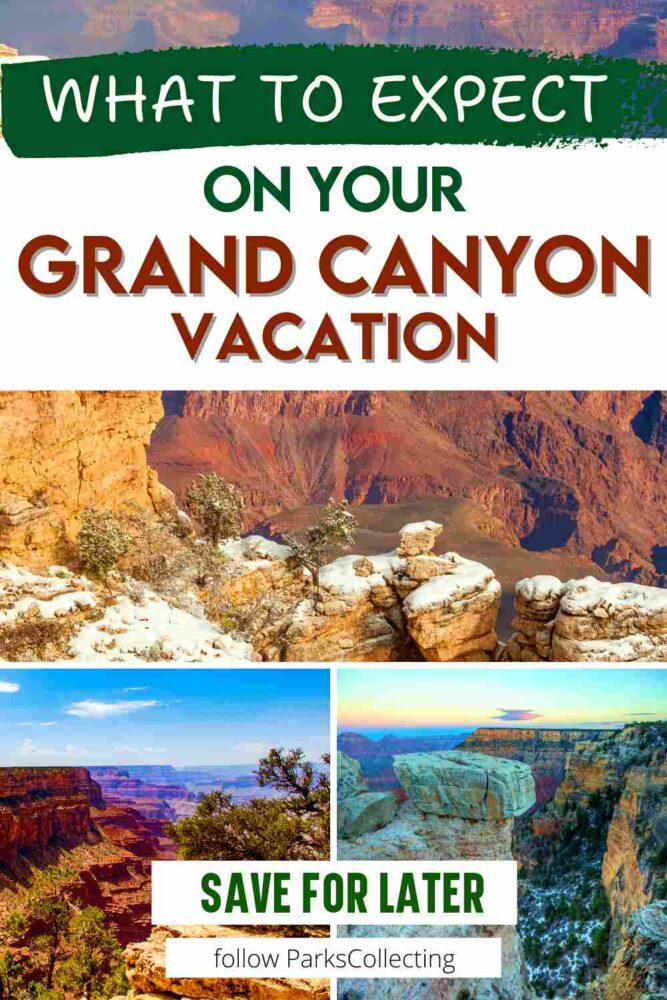
💡Are you just starting to think about taking a national parks trip? Get Inspiration
‼️ Are you looking for helpful tips for visiting US national parks? Read articles that share useful tips on a range of national-park related issues
💻 Are you starting to plan a trip to Grand Canyon National Park? Read my Guide to Grand Canyon National Park
📋 Do you want a ready-made super detailed plan for your trip to the Grand Canyon? Get a Deluxe 1 – 3-day South Rim Itinerary and Get a Basic 1-2-day North Rim Itinerary
🛏️ Are you looking for a place to stay near Grand Canyon National Park? Find a vacation rental near Grand Canyon National Park
💲 Are you ready to book your trip? Use these Planning and Booking Resources
📖 Do you want to read a book about Grand Canyon National Park? Check out my Recommended Reading List for Grand Canyon National Park
About the Author
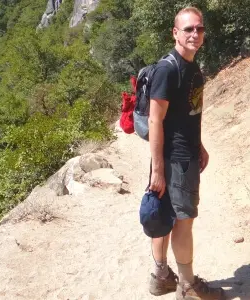
James Ian is a national park, camping and hiking expert.
He has dedicated his life to travel, visiting more than 80 countries, all 7 continents and most of the national parks in the United States. With over 35 years experience in the travel industry, James has worked on cruise ships, at resorts and hotels, and as a travel planner who’s helped hundreds of people plan successful trips to US national parks.
Based on his experience visiting our national parks multiple times, in-depth research and expertise as a travel planner, James has published detailed itineraries for many of the major national parks in the US. These itineraries, as well as in-depth park guides, and other resources will help you have your own incredible trip to US national parks without stress and hassle.
As a national park expert, James has contributed to many publications, including USA Today, Newsweek, Time Business News, Savoteur, Best Trip, and Wired.
I’m a member of the Amazon Services LLC Associates Program. As an Amazon Associate I earn from qualifying purchases.
